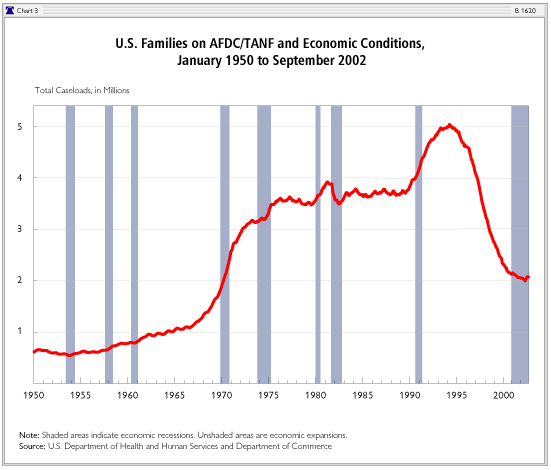This WebMemo is excerpted from a Heritage Backgrounder, The Continuing Good News About Welfare Reform , by Robert Rector and Patrick F. Fagan.
- Welfare Reform and the Current Recession
- Economy vs. Reform
- State Budget Recession
Welfare Reform and the Current Recession
When welfare reform was enacted, liberal opponents predicted that it would yield sharp increases in poverty even in good economic times; the effects of reform during a recession were expected to be disastrous. As noted, liberal predictions about the negative effects of reform during good economic times have been proven completely erroneous. Moreover, the disastrous effects expected of welfare reform during an economic downturn have, at least so far, failed to materialize during the current recession.
The fact that welfare caseloads have, up to now, declined during the current recession is good news. However, a note of caution is warranted. The effects of a recession in increasing welfare dependence may continue for several years after the onset of the recession. Thus, it is possible that TANF caseloads will rise during 2003. However, the recent trends in caseload strongly suggest that, if TANF caseloads do rise in 2003, the increase will be quite small when compared to increases spurred by prior recessions.
Overall, the health of the economy in the mid and late 1990s did serve as a positive background factor contributing to positive changes in welfare dependence, employment, and poverty. It is very unlikely, for example, that dramatic drops in dependence and increases in employment would have occurred during a prolonged recession. However, it is also certain that good economic conditions alone would not have produced the striking changes that occurred in the late 1990s. It is only when welfare reform was coupled with a growing economy that these dramatic positive changes occurred.
Economy vs. Reform
Some would argue that the positive results from Welfare Reform are the product of the robust economy during the 1990s. However, the evidence supporting an economic interpretation of these changes is not strong.

The above chart shows the AFDC caseload from 1950 to 2000. On the chart, periods of economic recession are shaded, and periods of economic growth are shown in white. Historically, periods of economic growth have not resulted in lower welfare caseloads. The chart shows eight periods of economic expansion prior to the 1990s, yet none of these periods of growth led to a significant drop in AFDC caseload. Indeed, during two previous economic expansions (the late 1960s and the early 1970s), the welfare caseload grew substantially. Only during the expansion of the 1990s does the caseload drop appreciably.
How was the economic expansion of the 1990s different from the eight prior expansions? The answer is welfare reform.
The chart does show that the national TANF decline has slowed appreciably during the current recession, which began in April 2001. Critics of reform might argue that this shows the state of the economy has been the dominant factor in the reduction of dependence. While it is true that the slowdown in the economy is affecting the decline in caseload, however, it is important to note the vast difference in trends before and after welfare reform. Prior to the mid-1990s, the AFDC caseload remained flat or rose during economic expansions and generally rose to a substantial degree during recessions. Since welfare reform, the welfare caseload has plummeted downward during good economic times and declined more slowly during the recession.
Thus, while the state of the economy does have an effect on AFDC/TANF caseloads, irrespective of economic conditions, the difference in caseload trends before and after reform is enormous. This difference is clearly due to the impact of welfare reform policies.
State Budget Recession
The rate of caseload decline varies enormously among the 50 states. If improving economic conditions were the main factor driving down caseloads, the variation in state reduction rates should be linked to variation in state economic conditions. On the other hand, if welfare polices are the key factor behind falling dependence, the differences in reduction rates should be linked to specific state welfare policies.
In a 1999 Heritage Foundation study, "The Determinants of Welfare Caseload Decline," author Robert Rector examined the impact of economic factors and welfare policies on falling caseloads in the states.
This analysis showed that differences in state welfare reform policies were highly successful in explaining the rapid rates of caseload decline. By contrast, the relative vigor of state economies, as measured by unemployment rates, changes in unemployment, or state job growth, had no statistically significant effect on caseload decline.
A recent paper by Dr. June O'Neill, former Director of the Congressional Budget Office, reaches similar conclusions (Gaining Ground? Measuring the Impact of Welfare Reform on Welfare and Work).
Dr. O'Neill examined changes in welfare caseload and employment from 1983 to 1999. Her analysis shows that in the period after the enactment of welfare reform, policy changes accounted for roughly three-quarters of the increase in employment and decrease in dependence. By contrast, economic conditions explained only about one-quarter of the changes in employment and dependence. Substantial employment increases, in turn, have led to large drops in child poverty.
Overall, the health of the economy in the mid and late 1990s did serve as a positive background factor contributing to positive changes in welfare dependence, employment, and poverty. It is very unlikely, for example, that dramatic drops in dependence and increases in employment would have occurred during a prolonged recession. However, it is also certain that good economic conditions alone would not have produced the striking changes that occurred in the late 1990s. It is only when welfare reform was coupled with a growing economy that these dramatic positive changes occurred.
This WebMemo is excerpted from a Heritage Backgrounder, The Continuing Good News About Welfare Reform , by Robert Rector and Patrick F. Fagan.




